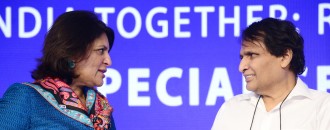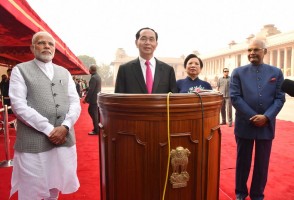
Domestic market key for India in an era of weak global demand
Sai Nikesh D | The Dollar Business  The Confederation of Indian Industry (CII), on Friday, conducted a conference aimed at improving business environment in India and also towards promotion of North India as a manufacturing hub. In the conference, a Memorandum of Understanding (MoU), focused at improving India’s ease of doing business and investments climate, has been signed between CII and the Lee Kuan Yew School of Public Policy, National University of Singapore (NUS). As per the MoU, the CII and NUS would be conducting state-level research activities in coordination with the respective State governments and prepare a state-level action plan for ease of doing business in the States. The CII-NUS joint state-level research across 11 parameters include starting a business, dealing with construction permits, land acquisition, protecting minority investors, trading across borders, enforcing contracts, resolving insolvency and labour market regulations, among others. Under the process, the NUS would first study current position of the States and will guide them on specific best practices, handhold them and would also analyze their improvement on year on year basis, said Chandrajit Banerjee, Director General (DG), CII. The CII DG further informed that the experts from Asia Competitiveness Institute (ACI) of the NUS have already discussed proposals and also received positive feedback from the State governments of Rajasthan, Delhi, Chhattisgarh and Madhya Pradesh, while more are in the pipeline. Meanwhile, Ajay Shriram, President, CII & Chairman & Senior Managing Director, DCM Shriram Ltd, called upon the States to be more pro-active in areas of labour reforms, reviving manufacturing, among others. He further remarked the States to be make themselves relevant in the minds of investors. Highlighting upon the Government of India’s Make in India, Zubin Irani, Chairman, CII Northern Region, said, “North India with its resource endowment, demographic advantage and strong consumption base, offers a variety of investment opportunities and can play a critical role in taking the ‘Make in India’ mission forward.” Investments are going to come in India, question is to which it will go, Zubin Irani pointed. Jayant Davar, co-chairman, CII National MSME Council, said, “Delhi-Mumbai Industrial Corridor (DMIC) project, which is focused on expanding India’s manufacturing and services base, is critical for the Northern region, as 52% of the influence area of the project falls in the region.” Expressing the industry perspective, Banmali Agrawala, President & CEO (South Asia), GE India, stated that it’s the natural resources base and investor-friendly government besides a larger demand size, that would attract investments in India. He, however, called for the investments in research and innovation across Indian States, especially in view of enhancing the affordability of products and services. Referring to the decentralization and regional competitive dynamics as key elements of China’s growth, Prof Tan Kong Yam, Co-Director, Asia Competitiveness Institute, NUS, called India also to promote a similar kind of learning to develop dynamism in the States. Prof Tan Kong Yam further stated that the recent labour reforms provide a larger scope for India’s growth, in view of China’s rising wages and exchange rates. The real advantage for India lies in its larger domestic market in an era of weak global demand, he added. As per the extracts from the theme of ‘Make in India: Focus North” on sectoral opportunities in Northern Region, the major areas of focus include Automobile & Auto Components, Defence& Aerospace, Electronics & IT hardware, Construction, Food Processing, Biotechnology and Pharmaceutical sectors.
The Confederation of Indian Industry (CII), on Friday, conducted a conference aimed at improving business environment in India and also towards promotion of North India as a manufacturing hub. In the conference, a Memorandum of Understanding (MoU), focused at improving India’s ease of doing business and investments climate, has been signed between CII and the Lee Kuan Yew School of Public Policy, National University of Singapore (NUS). As per the MoU, the CII and NUS would be conducting state-level research activities in coordination with the respective State governments and prepare a state-level action plan for ease of doing business in the States. The CII-NUS joint state-level research across 11 parameters include starting a business, dealing with construction permits, land acquisition, protecting minority investors, trading across borders, enforcing contracts, resolving insolvency and labour market regulations, among others. Under the process, the NUS would first study current position of the States and will guide them on specific best practices, handhold them and would also analyze their improvement on year on year basis, said Chandrajit Banerjee, Director General (DG), CII. The CII DG further informed that the experts from Asia Competitiveness Institute (ACI) of the NUS have already discussed proposals and also received positive feedback from the State governments of Rajasthan, Delhi, Chhattisgarh and Madhya Pradesh, while more are in the pipeline. Meanwhile, Ajay Shriram, President, CII & Chairman & Senior Managing Director, DCM Shriram Ltd, called upon the States to be more pro-active in areas of labour reforms, reviving manufacturing, among others. He further remarked the States to be make themselves relevant in the minds of investors. Highlighting upon the Government of India’s Make in India, Zubin Irani, Chairman, CII Northern Region, said, “North India with its resource endowment, demographic advantage and strong consumption base, offers a variety of investment opportunities and can play a critical role in taking the ‘Make in India’ mission forward.” Investments are going to come in India, question is to which it will go, Zubin Irani pointed. Jayant Davar, co-chairman, CII National MSME Council, said, “Delhi-Mumbai Industrial Corridor (DMIC) project, which is focused on expanding India’s manufacturing and services base, is critical for the Northern region, as 52% of the influence area of the project falls in the region.” Expressing the industry perspective, Banmali Agrawala, President & CEO (South Asia), GE India, stated that it’s the natural resources base and investor-friendly government besides a larger demand size, that would attract investments in India. He, however, called for the investments in research and innovation across Indian States, especially in view of enhancing the affordability of products and services. Referring to the decentralization and regional competitive dynamics as key elements of China’s growth, Prof Tan Kong Yam, Co-Director, Asia Competitiveness Institute, NUS, called India also to promote a similar kind of learning to develop dynamism in the States. Prof Tan Kong Yam further stated that the recent labour reforms provide a larger scope for India’s growth, in view of China’s rising wages and exchange rates. The real advantage for India lies in its larger domestic market in an era of weak global demand, he added. As per the extracts from the theme of ‘Make in India: Focus North” on sectoral opportunities in Northern Region, the major areas of focus include Automobile & Auto Components, Defence& Aerospace, Electronics & IT hardware, Construction, Food Processing, Biotechnology and Pharmaceutical sectors.
This article was published on March 20, 2015.





 to success.
to success.